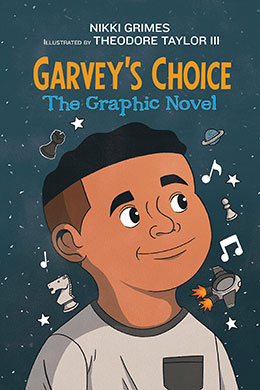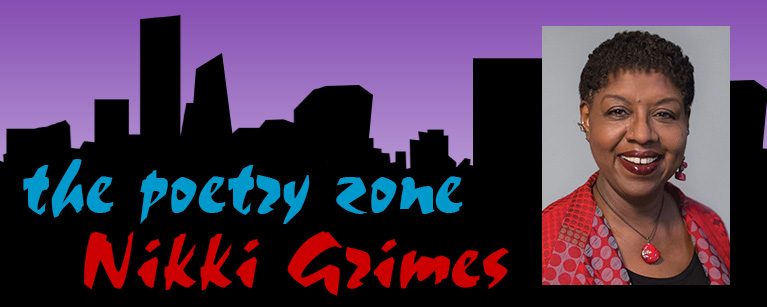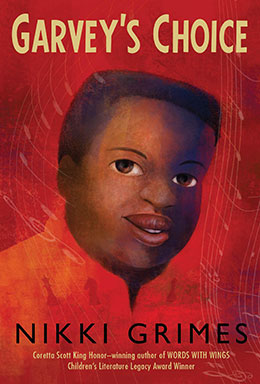
written by Nikki Grimes
WordSong, October 2016
Buy this book:
hardcover
Cellar Door Bookstore (signed)
Bookshop.org (local booksellers)
paperback
Cellar Door Bookstore (signed)
Bookshop.org (local booksellers)
e‑book
Read more about Garvey
Garvey’s Choice the Graphic Novel
Garvey’s father has always wanted Garvey to be athletic, but Garvey is interested in astronomy, science fiction, reading—anything but sports. Feeling like a failure, he comforts himself with food. Garvey is kind, funny, smart, a loyal friend, and he is also overweight, teased by bullies, and lonely.
When his only friend encourages him to join the school chorus, Garvey’s life changes. The chorus finds a new soloist in Garvey and, through chorus, Garvey finds a way to accept himself, and a way to finally reach his distant father—by speaking the language of music instead of the language of sports.
This emotionally resonant novel in verse by award-winning author Nikki Grimes celebrates choosing to be true to yourself.
Awards and Recognition
-
School Library Journal 2023 Best Book/Graphic Novel category
Reviews
A very good graphic novel adaptation of a well-loved Nikki Grimes title, Garvey’s Choice. Both words and illustrations are true to the original content. This graphic novel will pull in some children who may be hesitant to read the original. More than 2/3 of the Tanka poems in the original are still in this version. Nothing is lost in the remaining short poems that are true to the original tones of the first version. Words are well supported by excellent illustrations. The illustrations are clean, uncluttered and reflect the often serious tone about the depth of pain and eventual climb toward a reshaping of a more joyful identity of the main character. Color and facial expressions do a good job with the intense internal conversations Garvey has with himself and the interactions he has with family members, friends and others. (Stephanie Wolflink, Youth Services Book Review, starred review)
Grimes’ acclaimed novel in verse sees new life in comics format. Garvey, an imaginative young Black boy, loves reading SF and stargazing, but his father would rather he play sports. Feeling unheard, he copes by overeating and is mocked for his weight at school. But through new friendships and a passion for music, Garvey forges a path to self-confidence and finds a way to connect with his father. Grimes’ tanka poems, kept mostly intact with minor edits and some changes to their order, pair nicely with Taylor’s straightforward illustrations, bringing to life Garvey’s story of newfound self-possession. The energetic illustrations playfully depict his rocky journey toward a truer version of himself, providing levity at times but never shortchanging the most poignant moments. The poem “Stars” offers a breezy portrayal of Garvey’s extraterrestrial fantasies: “Stars on my ceiling / Wink at me when the full moon / comes for a visit.” In “Shadow,” the magnitude of his feelings about body image and his emotional eating becomes clear, with Garvey looming above his comparatively tiny family: “Whenever I stand near that’s / how it feels. They’re all so small.” These charming, reflective poems are an ideal match for Taylor’s endearing first graphic novel endeavor. An adaptation that expands the world of a captivating, much-loved character. (Kirkus Reviews)
Garvey loves chess and science fiction, much to the dismay of his father, who wants to play football with his son the way he did with his own father. Garvey feels like he’s letting his father down, but he can’t do anything about it. Nor can he help the fact that the kids in school tease him about his weight. But he has a good team on his side, including his sister Angie, who got the athletic ability in the family, and his friend Joe. Things start to improve when Joe persuades him to join the school chorus. Garvey makes a new friend, Manny, who has albinism and who helps him learn to ignore the teasing. And in a nice twist, music turns out to be that one special thing Garvey can share with his father. Grimes wrote the original version of Garvey’s Choice in a type of Japanese non-rhyming verse called tanka. Although she slightly modified the text for this graphic novel, the effect still comes through: The story is broken into bite-size pieces, each page or spread depicting a single moment. Taylor’s art has a minimum of detail but plenty of emotional impact. (School Library Journal)
Grimes’ award-winning tanka poem narrative about a boy struggling to find a place for himself in his family and the world is adapted in this captivating, visually impressive graphic, which looks at Garvey from a slightly different perspective. Garvey knows that binge eating is not a healthy solution for navigating the pain of feeling like a constant disappointment to his father who has clear expectations about what a Black man should be, or for handling bullying and isolation at school, but he doesn’t have a better therapeutic tool. When he finally finds the school chorus, it is a revelation: here is a way to engage with the world, to share his gifts, to negotiate his hurt, and to maybe even relate to his father who also has a strong connection with music. His relationship with eating changes, and he adjusts to moderate exercise and a more measured approach to food, although (refreshingly) Garvey does not condemn his earlier behaviors nor obsess over the exact extent of his weight loss. The digital illustrations are arranged to retain the feeling of vignettes building to a whole, using empty space, page transitions, and thoughtful panel sizes to support the structure of the poems. In an author’s note, Grimes explains how some of the original poems, carefully written using the traditional tanka syllable count and format, needed to be adapted for a visual medium with speech bubbles; the occasional loss of flow from the original is easily compensated for with the emotionally rich illustrations. (Bulletin of the Center for Children’s Books)





